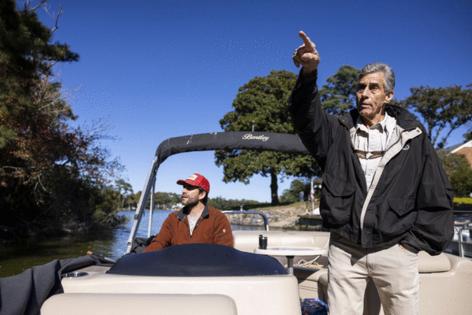A mysterious Virginia Beach island may hold pirate secrets. An archeological survey is planned.
Published in News & Features
VIRGINIA BEACH, Va. — A mysterious man-made island with a possible pirate connection in Virginia Beach’s Lake Joyce has piqued the interest of a local real estate attorney who recently bought the land to preserve it.
Hayden DuBay is determined to uncover the origins of “Blackbeard’s Island,” as it is referred to in its legal description, by digging up any possible artifacts it may contain through a self-funded archeological undertaking. But he faces an uphill battle as there are sparse clues to back up local pirate legends and healthy speculation among some historians who have yet to fully explore the island.
The Hampton Roads region has a rich pirate history. Cape Henry, at the entrance to the Chesapeake Bay, was known as a spot where pirates would lay in wait for merchant vessels laden with valuable cargo. Determining whether the island existed during the golden age of piracy from 1660 to 1730 is one of DuBay’s goals.
“Historically, no one knows when it was done, why it was done or by whom it was done,” he said. “It truly is a historical mystery.”
Mystery island
DuBay first set foot on the uninhabited island about 40 years ago when he moved to Virginia Beach and later built a house on Lake Joyce, off Shore Drive. The island was owned by the Collier family who had developed the Bay Lake Pines neighborhood. Neighbors living on the lake would visit the wooded retreat to play on a rope swing. Boy Scouts camped there overnight, DuBay said.
His son, Derek, remembers swimming to the island as a child.
“When you’re a kid and you’re on the island, you never really realized it was anything other than a place to escape from mom and dad,” Derek DuBay said.
But he and his father soon became intrigued by the pristine nature of the land and its unique characteristics. It features a large ridge on its east side that rises 35 feet and helps to fortify the 3-acre land mass. A narrow canal separates it from the mainland. DuBay wondered how and why the island came into existence.
Two years ago, DuBay bought the island for $500,000 from the Colliers and started a deep dive with Carol Butler, a real estate title expert/historical researcher, into the area’s history.
They researched the Thoroughgood family, who built a home on the shores of Lake Joyce and owned swaths of land there nearly 400 years ago. He also studied the numerous battles and wars that touched the shores of the nearby mouth of the Chesapeake Bay, which may have been visible from the tallest point on the island.
One of the earliest records DuBay has found so far that mentions the island and its possible connection to pirates is a book published in 1853, “Historical and Descriptive Sketches of Norfolk and Vicinity,” by William S. Forrest.
It looks at 200 years of history to 1640 and describes the island as covered in trees.
“The origin of this mound, or more properly, this old fortification, is involved in mystery,” Forrest wrote. “Who can declare that this was not one of the places of retreat and defence of Blackbeard, the notorious brigand and pirate, and his fearful gang of hardened, bloodthirsty freebooters, with their treasures of gold, jewelry, precious stones, and untold wealth?”
The passages in the book have only further fueled DuBay’s desire to unlock the island’s secrets.
“We’ve got a historical description of the island, but what we’ve found is, in the historical description, it was a mystery,” said DuBay. “We came to the conclusion that the only way we’re going to get an answer is by doing archeology.”
A lookout point
On a recent afternoon, DuBay stepped through a patch overgrown weeds and pulled back a tree branch on the island’s highest point.
It has been speculated that centuries ago pirates may have stood watch in the same spot, keeping an eye out for merchant ships entering the mouth of the Chesapeake Bay at Cape Henry, said DuBay.
Through the years, locals have referred to it as Treasure Island and Blackbeard’s Island, among other monikers.
The notorious pirate Blackbeard was active during the early 1700s. At that time, Lake Joyce was part of Lynnhaven Bay. After Adam Thoroughgood died in 1640, his wife, Sarah, opened Pleasure House, a colonial tavern that was a hangout for seaman and eventually pirates. It was accessible from Lake Joyce. Blackbeard considered the Virginia Capes his stomping ground, according to historical accounts. DuBay mused that it’s possible he went to Pleasure House.
“If there was a place to get a beer, he probably was over there with his guys, too,” said DuBay, who wonders if the pirates set up a camp on the island.
Butler found a 1933 article from The Virginian-Pilot about the uncovering of skeletons near Lake Joyce, which draws ties to the island and Blackbeard.
“Not more than 400 yards from the place where Blackbeard is reputed to have maintained an armed fortress in Lake Joyce 218 or 220 years ago — workmen yesterday unearthed 12 human skeletons …,” the article said.
It theorizes about the island’s origins.
“Legend has it that Blackbeard and his pirates constructed this island and built on it a fortress where they could protect themselves from harassed merchant seaman upon whom they preyed,” and that other Virginia pirates made the island the base of their operations and their hideout when they were not attacking ships coming in and out of the Virginia Capes, according to the article.
The island was variously known as Blackbeard’s Den, Treasure Island and Pirate’s Fort.
“For years it has been popular in the legends of Princess Anne County that Blackbeard and other pirates buried treasure on or near the island. If this was done, none of it ever has been found,” the article said.
A mystery shrouded in questions
Nicholas Luccketti, a historian with the James River Institute for Archaeology, believes it’s highly unlikely pirates built the island and further research is necessary to draw any connections. Two years ago, when DuBay first contacted him, he and former colleague Matt Laird determined the island probably wasn’t used as a fortress during battles or wars, but agreed that the channel was dug for a reason yet to be explained.
Based on initial consultation with an engineer, DuBay believes the 35-foot earthen mound on the island is a result of the excavation of the adjacent canal. It likely would have taken a hundred people several months.
“Someone purposefully moated the island,” he said. “It was a major undertaking.”
DuBay recently met with the William & Mary Center for Archeological Research and conducted an analysis of the soil. An archeological survey is planned next spring. It could cost $50,000 or more just for the preliminary work, DuBay said.
“It’s a big question mark, a big unknown over there,” said DuBay. “We’re treating it like a scientific undertaking one step at a time.”
The island is being protected during research and archeology work so artifacts are not destroyed.
“Somebody went to a lot a work to create this canal, separate themselves from off the mainland, be protected on all four sides, but we don’t know who,” he said. “It has a story to tell.”
-----------
©2025 The Virginian-Pilot. Visit at pilotonline.com. Distributed by Tribune Content Agency, LLC.







Comments